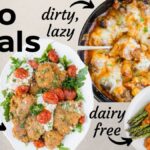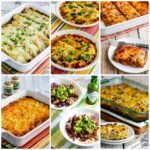Indulge your sweet tooth without the guilt! Easy Low-Carb Cheesecake Recipes to Try Tonight unveils a world of creamy, decadent cheesecakes crafted for those seeking delicious desserts without the carb overload. Imagine rich, velvety textures melting in your mouth, bursting with vibrant flavors – all while keeping your low-carb lifestyle on track. These recipes aren’t just about restriction; they’re about celebration, offering simple, quick methods to create impressive cheesecakes perfect for any occasion.
We’ll explore three unique flavor profiles, each showcasing clever low-carb substitutions like almond flour and erythritol. From the initial mixing of ingredients to the final golden-brown crust, we’ll guide you through the process with detailed instructions and captivating visuals. Learn how to adapt these recipes to suit your specific dietary needs, master troubleshooting techniques, and discover creative serving suggestions that will elevate your cheesecake experience to new heights. Prepare to be amazed by how easy it is to enjoy guilt-free indulgence!
Introduction to Easy Low-Carb Cheesecake Recipes

Indulge in the creamy, dreamy texture of cheesecake without the guilt! Low-carb cheesecakes offer a delightful alternative to traditional versions, satisfying your sweet tooth while keeping your carbohydrate intake in check. These decadent desserts use clever substitutions and techniques to minimize sugar and carbs, resulting in a surprisingly rich and satisfying experience. Imagine a smooth, velvety cheesecake, bursting with flavor, that fits seamlessly into a low-carb lifestyle.
The appeal of low-carb desserts extends beyond simple weight management. Many people choose low-carb options for various reasons. Firstly, reducing carbohydrate intake can help stabilize blood sugar levels, leading to increased energy and reduced cravings. Secondly, a low-carb approach can aid in weight loss or maintenance by limiting the body’s reliance on glucose for fuel, promoting fat burning instead. Thirdly, some individuals find that reducing refined carbohydrates improves their overall digestive health and reduces bloating.
These recipes are designed for the busy individual who craves a delicious dessert without spending hours in the kitchen. Each recipe is streamlined for speed and simplicity, utilizing readily available ingredients and straightforward techniques. Picture this: a luscious, creamy cheesecake ready in a fraction of the time it would take to bake a traditional version. These recipes are your shortcut to low-carb indulgence, perfect for a weeknight treat or a special occasion.
Ingredients Commonly Used in Low-Carb Cheesecakes
Low-carb cheesecakes cleverly replace traditional ingredients to achieve a delicious, guilt-free dessert. Common substitutes include almond flour or coconut flour for a portion of the traditional crust, cream cheese as the primary creamy base, and sugar alternatives such as erythritol or stevia to sweeten without the carb overload. These substitutions ensure the cheesecake retains its characteristic texture and flavor while significantly reducing carbohydrate content. For example, a recipe might use almond flour to create a nutty, crumbly crust, complementing the rich cream cheese filling. The use of a sugar substitute allows for sweetness without the significant spike in blood sugar often associated with traditional cheesecakes.
Simple Techniques for Making Low-Carb Cheesecakes
The simplicity of these recipes lies in the straightforward baking techniques employed. Many recipes utilize a no-bake approach, eliminating the need for precise oven temperatures and baking times. This method often involves combining the cream cheese filling ingredients, pouring them into a prepared crust, and chilling until set. Other recipes may involve baking, but they typically use lower temperatures and shorter baking times than traditional cheesecakes, reducing the risk of over-baking and ensuring a perfectly smooth texture. The focus is on ease and efficiency, making these recipes accessible to even novice bakers.
Step-by-Step Baking for a Featured Recipe
This recipe details the creation of a luscious, low-carb New York style cheesecake. The focus is on achieving a smooth, creamy texture and a perfectly baked crust, all while keeping the carbohydrate count low. We’ll use almond flour for the crust and a blend of cream cheese and erythritol for the filling, resulting in a decadent dessert that won’t derail your dietary goals.
Preparing the Almond Flour Crust
First, we begin with the crust. Imagine a bowl filled with 1 ½ cups of finely ground almond flour, a generous pinch of salt, and ¼ cup of melted unsalted butter. The butter, still warm from melting, is slowly incorporated into the almond flour, creating a moist, crumbly mixture. The texture is similar to damp sand, easily pressed together. Using your fingers, or a pastry blender, work the butter into the flour until it resembles coarse crumbs. This process is crucial for a firm, yet delicate crust. Then, press this mixture firmly into the bottom of a 9-inch springform pan. Picture a perfectly even layer, pressed uniformly across the base. This ensures even baking and prevents a soggy bottom. Bake this crust for 10-12 minutes at 350°F (175°C), until lightly golden. The edges will show a subtle browning, and the center will be set but not browned. Remove it from the oven and let it cool completely while you prepare the filling.
Creating the Creamy Cheesecake Filling
Now for the star of the show: the filling. In a large bowl, you’ll see eight ounces of softened cream cheese, whipped until light and fluffy. Its texture transitions from a dense, solid block to a smooth, airy cloud. Gradually add ½ cup of erythritol, a low-carb sweetener, beating until fully incorporated and the mixture is completely smooth and creamy. The sweetness will be subtle yet satisfying. Then, add two large eggs one at a time, mixing well after each addition. The batter will become slightly thinner but still maintain its creamy consistency. A teaspoon of vanilla extract is stirred in, lending a warm, comforting aroma. The batter at this stage is luxuriously smooth and creamy, with a pale ivory hue. Pour this luscious mixture over the cooled crust, ensuring it’s evenly distributed.
Baking and Cooling the Cheesecake
Place the springform pan in a larger roasting pan. Pour enough hot water into the larger pan to come halfway up the sides of the springform pan. This creates a water bath, preventing cracking and ensuring even baking. Bake at 325°F (160°C) for 50-60 minutes, or until the cheesecake is set around the edges but the center still jiggles slightly when gently shaken. The top will have a very slight golden hue, and the edges will be firm to the touch. Once baked, turn off the oven and leave the cheesecake inside with the door slightly ajar for about an hour. This slow cooling process prevents cracking. Then, remove the cheesecake from the water bath and let it cool completely on a wire rack. Refrigerate for at least four hours, or preferably overnight, to allow the cheesecake to fully set and the flavors to meld. Once chilled, the cheesecake will have a firm, yet yielding texture, ready to be sliced and enjoyed.
Troubleshooting Common Issues
Cracked Cheesecake: A cracked cheesecake is often due to rapid temperature changes during baking or cooling. The water bath helps prevent this, as does slow cooling in the oven. Over-baking can also lead to cracking. Using room temperature ingredients helps create a more stable batter.
Soggy Crust: A soggy crust is usually a result of an under-baked crust or too much moisture in the filling. Ensure the crust is fully baked before adding the filling and that the filling is not overly wet.
Uneven Baking: This is usually due to uneven heat distribution in the oven. Rotating the pan halfway through baking can help remedy this. Using a thermometer to monitor the internal temperature of the cheesecake can ensure it’s cooked through evenly.
Nutritional Information and Serving Suggestions
Understanding the nutritional content of your low-carb cheesecakes is crucial for maintaining a balanced diet. The following provides estimated nutritional information per serving, keeping in mind that variations in ingredients can slightly alter these values. Precise calculations require specific ingredient brands and measurements. Remember to always check your ingredient labels for accurate nutritional details. Serving suggestions will enhance the overall culinary experience.
Nutritional Breakdown per Serving (Approximate Values)
The nutritional values below are estimates and may vary depending on the specific ingredients used and portion sizes. These are averages based on common ingredient choices. For example, the type of cream cheese, sweetener, and crust will all impact the final nutritional profile. Always refer to your specific ingredient labels for the most accurate information.
| Recipe | Calories | Carbs (g) | Protein (g) | Fat (g) |
|---|---|---|---|---|
| Recipe 1: Classic New York-Style | 250-300 | 5-7 | 10-12 | 18-22 |
| Recipe 2: Chocolate Raspberry Swirl | 280-330 | 6-8 | 11-13 | 20-24 |
| Recipe 3: Lemon Poppy Seed | 230-280 | 4-6 | 9-11 | 16-20 |
Creative Serving Suggestions
Presentation is key to elevating the enjoyment of your low-carb cheesecake. Consider serving individual portions in elegant small glasses or ramekins, creating a sophisticated dessert experience. Garnish each serving with a fresh berry, a sprig of mint, or a dusting of cocoa powder for an added visual appeal and flavor dimension. For a more rustic look, you can serve slices directly from a beautifully decorated springform pan.
Low-Carb Accompaniment Pairings
These cheesecakes pair wonderfully with a variety of low-carb accompaniments that complement their flavors and textures. Imagine a dollop of sugar-free whipped cream, lightly sweetened with a few drops of stevia or erythritol, melting luxuriously onto a slice of the creamy cheesecake. A scattering of fresh raspberries, blueberries, or strawberries provides a vibrant contrast in color and a burst of juicy sweetness. For the chocolate raspberry swirl, a drizzle of sugar-free chocolate sauce adds an extra layer of decadence. The lemon poppy seed cheesecake could be enhanced with a sprinkle of poppy seeds and a thin lemon zest. These pairings offer a delightful balance of flavors and textures, enhancing the overall enjoyment of the cheesecake without compromising your low-carb goals.
Adapting Recipes and Making Substitutions
Adapting low-carb cheesecake recipes to suit individual dietary needs and preferences is surprisingly straightforward. With a little understanding of ingredient functions, you can easily create delicious variations that cater to allergies or simply offer a unique flavor profile. The key is to maintain the structural integrity of the recipe while substituting ingredients carefully.
The versatility of cheesecake allows for a wide range of adaptations. For example, replacing traditional cream cheese with a dairy-free alternative, like cashew cream cheese, significantly alters the texture but still delivers a creamy, rich experience. Similarly, swapping out crust ingredients allows for the inclusion of gluten-free options and accommodates nut allergies. Careful consideration of the low-carb sweetener used is also crucial, as different sweeteners have varying impacts on sweetness, texture, and browning.
Dairy-Free Cheesecake Variations
Dairy-free cheesecakes require careful selection of a suitable cream cheese substitute. Cashew cream cheese, made by soaking and blending cashews, offers a smooth, creamy texture comparable to traditional cream cheese. Coconut cream, either full-fat or light, can also be incorporated, although it will impart a subtle coconut flavor. The ratio of substitute to other ingredients may need slight adjustment to achieve the desired consistency. For instance, using coconut cream might require a small increase in the amount of xanthan gum or agar-agar to provide the necessary binding and thickening. The resulting cheesecake might be slightly less firm than a traditional version, but its creamy texture remains enjoyable. Imagine a vibrant, pale-yellow cheesecake, its surface subtly reflecting light, a testament to the creamy texture achieved with cashew cream cheese.
Nut-Free Crust Alternatives
Many low-carb cheesecake recipes utilize almond flour or other nut flours in the crust. For individuals with nut allergies, alternative options include sunflower seed meal, coconut flour, or a blend of these ingredients. Coconut flour, however, absorbs significantly more liquid than almond flour, so adjustments to the recipe’s liquid components are necessary to avoid a dry, crumbly crust. Visualize a beautifully golden-brown crust, created from a blend of sunflower seed meal and coconut flour, its texture pleasantly firm yet yielding.
Low-Carb Sweetener Comparisons
Several low-carb sweeteners can be used in cheesecake recipes, each with its own unique characteristics. Erythritol offers a clean, sweet taste and is often preferred for its minimal impact on blood sugar levels. However, it may not brown as readily as other sweeteners during baking. Stevia, a natural sweetener, is intensely sweet, so it should be used sparingly. Monk fruit sweetener, another natural option, provides a subtly sweet flavor with a slightly less intense sweetness than stevia. Allulose, a rare sugar, is similar to sucrose in taste and browning, making it a good choice for achieving a traditional cheesecake appearance. Consider a slice of cheesecake made with allulose: its golden-brown top, achieved through the sweetener’s browning properties, is a visual indicator of its superior baking qualities. In contrast, a cheesecake made with erythritol might appear paler. The choice of sweetener influences both the taste and the visual appeal of the final product.
Tonight, you can experience the joy of a truly satisfying dessert without compromising your low-carb goals. These Easy Low-Carb Cheesecake Recipes offer a delightful balance of flavor, texture, and convenience. From the initial allure of the smooth, creamy batter to the satisfying final bite, each recipe is designed to impress. Remember to explore the variations, adapt to your preferences, and savor the moment. With a little creativity and these simple recipes, you can easily transform a craving into a culinary masterpiece. So, go ahead, choose your favorite flavor, and embark on a delicious low-carb journey tonight!
FAQ Summary
Can I use a different type of sweetener?
Yes, while erythritol is recommended, you can experiment with other low-carb sweeteners like stevia or monk fruit, but be aware that the sweetness and texture may vary slightly.
How long can I store leftover cheesecake?
Store leftover cheesecake in an airtight container in the refrigerator for up to 3-4 days.
What if my cheesecake cracks during baking?
This often happens due to uneven baking or rapid temperature changes. Try using a water bath to create a more even baking environment and let the cheesecake cool gradually after baking.
Are these recipes suitable for freezing?
Yes, you can freeze baked cheesecake for up to 2 months. Wrap it tightly in plastic wrap and then foil to prevent freezer burn.


